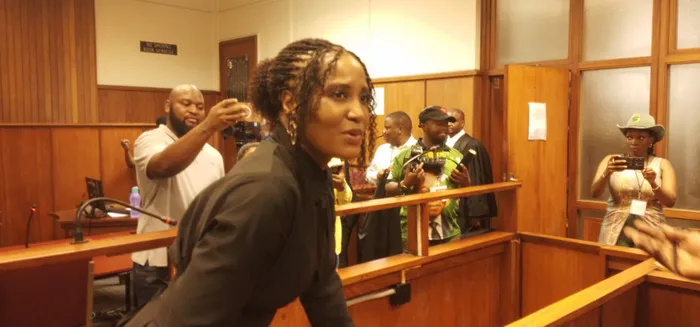Duduzile Zuma-Sambudla trial: Defence challenges evidence of incitement from 'we see you' comment

Umkhonto weSizwe Party member of Parliament Duduzile Zuma-Sambudla appeared in Durban High Court on Monday.
Image: Willem Phungula
Duduzile Zuma-Sambudla's lawyers on Monday challenged the State to provide evidence of how her tweet ‘ we see you’ on X, allegedly incited the July 2021 civil unrest in Gauteng and KwaZulu-Natal, following the jailing of her father, former president Jacob Zuma, for contempt of court.
More than 300 people were killed in the riots and looting that cost the economy billions of Rand.
Zuma-Sambudla, pleaded not guilty at the commencement of the trial.
Zuma-Sambudla faces three counts emanating from her social media posts during the civil unrest. Count one is incitement to commit the offence of terrorism, with the state alleging that between 29 June and 15 July 2021, in various places within the country, Zuma-Sambudla unlawfully and intentionally incited others to commit terrorism by engaging in terrorist activities.
On count two, which is incitement to commit violence, the state alleges Zuma-Sambudla incited, instigated, commanded or procured other persons to unlawfully assemble with common intent to forcibly disturb the public peace or tranquility or to invade the rights of other persons. On count three, the state also accused her of violating Section 17 of the Riotous Assemblies Act, 17 of 1956 which deals with the illegal assembling of persons with the intention to cause a riot.
Zuma-Sambudla’s attorney, Advocate Dali Mpofu SC cross-examined Major General Gopal Gounden from the Directorate of Priority Crimes Investigations (DPCI).
Mpofu asked Gounden how the sharing of pictures and videos of burning trucks and property and then posting ‘we see you’ on social media, can be construed as inciting people.
Mpofu argued that the State has no case against Zuma-Sambudla, except that she is the daughter of former president Jacob Zuma.
“What other messages did she write for the State to conclude that she allegedly incited people to go and loot. Why did the police not charge the persons that posted pictures and videos of burning shops,” argued Mpofu
The prosecution, led by Advocate Yuri Gangai, responded that the people that posted those videos did not write inciting messages, however, Zuma-Sambudla did when she wrote ‘we see you’. It also argued that the ‘we see you’ messages must be read in the context of the preceding messages from 30 June, a day after the Constitutional Court sentenced her father to 15 months of direct imprisonment.
Gangai alleged that in her preceding tweets, she wrote in Zulu: "Comrades, the time for fighting using cellphones is now over, amandla!".
Gangai argued that this message coupled with later images of burning trucks and shops and the caption of ‘ we see you’ was an endorsement of what the people were doing, therefore it constituted incitement.
Earlier, Gounden testified that the unrest was well coordinated and well executed, dismissing the suggestion that people simply reacted to former president Zuma’s incarceration.
Gounden was coordinator of the team that investigated the unrest.
He told the court that there were 164 WhatsApp groups that were created specifically to instigate unrest as a direct response to Zuma’s incarceration.
However, he said after investigation, police focused on eight WhatsApp groups which he said actively ran and coordinated the unrest. He stated that in these groups there were direct instructions to people on the ground on what to do and when. He further revealed that the most active groups were the ones in eThekwini, which had 316 people.
"There were two WhatsApp groups in eThekwini. One was in the INK area which is Inanda, Ntuzuma and KwaMashu and the other was known as eThekwini. We discovered 103 persons of interest in these groups. The unrest was well coordinated. Some of these groups were created around 29 June, 2021 which is the date when the Constitutional Court ordered the arrest of Zuma,” said Gounden.
The State maintained that Zuma-Sambudla, because of her public status as Zuma’s daughter, coupled with her 124,000 X followers, assumed the title of social media influencer therefore what she wrote on her page was taken seriously by people.
While the State conceded that Zuma-Sambudla was not linked to several WhatsApp groups that had been created at the time of the unrest, however, some of the members of the groups were her followers on X.
The case continues.
willem.phungula@inl.co.za
Related Topics: